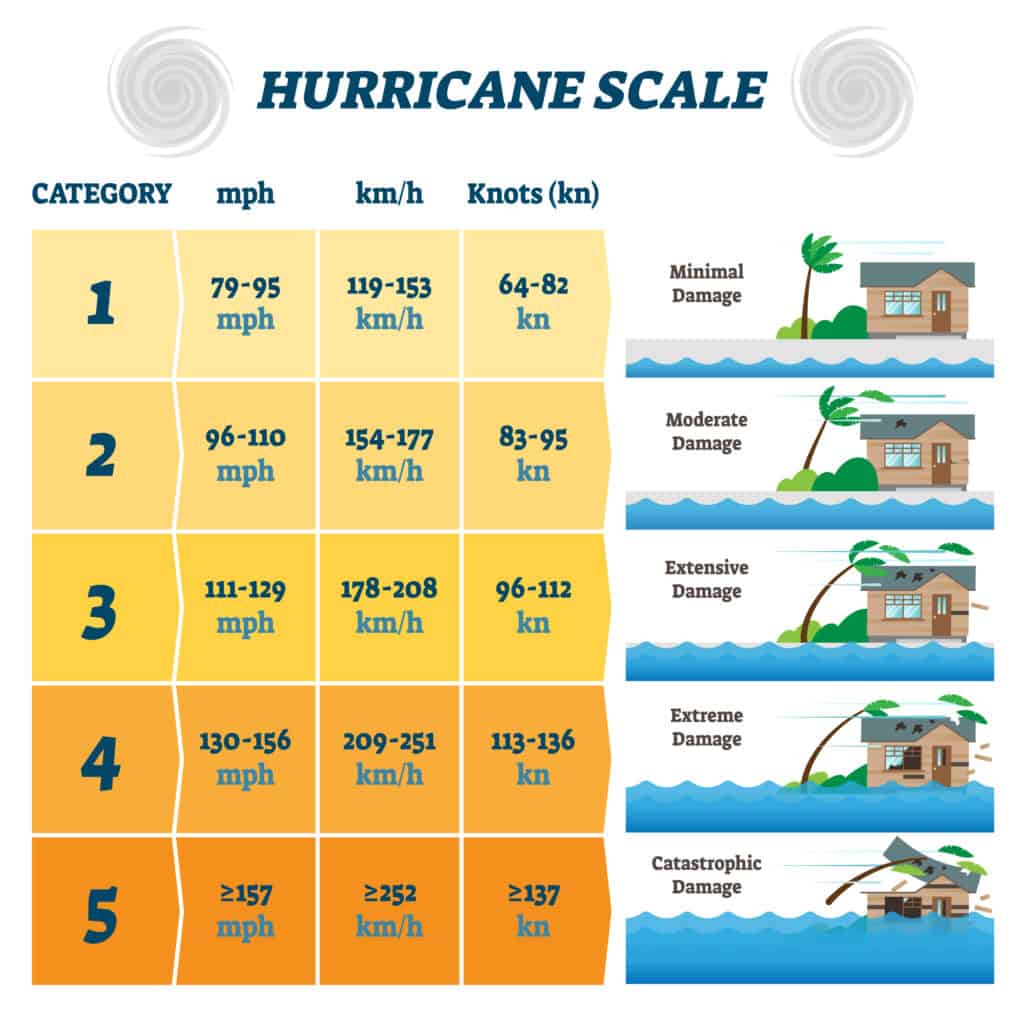The Gulf and Atlantic coasts of the United States are notorious for the ferocity of their hurricanes. However, hurricanes seldom make landfall in New Jersey. Most of the destructive storms experienced by this state are tropical storms and Nor’easters. So, what was the most powerful hurricane to ever hit New Jersey? Read on to learn this and more.
Saffir-Simpson Hurricane Wind Scale
Meteorologists measure hurricane intensity using the Saffir-Simpson Hurricane Wind Scale. It does not consider destructive forces such as rainfall, storm surge, flooding, or tornadoes. The Saffir-Simpson scale uses wind speed to estimate how much structural damage a hurricane might inflict on structures in its path. The scale measures intensity on a scale of 1 to 5, with a Category 5 hurricane being the most destructive. Category 1 storms have winds ranging from 79 to 95 mph, while Category 5 winds begin at 157 mph.

The Saffir-Simpson Hurricane Wind Scale is what the National Hurricane Center uses to categorize storms.
©VectorMine/Shutterstock.com
When is Hurricane Season In New Jersey?
Hurricane season begins on June 1st and ends on November 30th, though hurricanes can occur outside this date range. Also, hurricane season starts earlier these days due to climate change. Most hurricanes occur from August through October, with September being the busiest month.
What Was the Most Powerful Hurricane to Ever Hit New Jersey?
Now we know more about hurricane intensity and the boundaries of hurricane season. Let’s examine the most powerful hurricane ever to hit New Jersey. The aptly named “New Jersey Hurricane” of 1903 is the only hurricane in New Jersey’s history. A Category 1 storm, it made landfall in Atlantic City on September 16th, bringing winds over 80 mph.
Impact of the Hurricane
The hurricane inflicted a great deal of damage along the New England coast. It destroyed boats, damaged shorelines, and cost the lives of several sailors. Fatalities in New Jersey were limited to one indirect fatality when the obstructed vision of a driver led to his collision with a train. Damages in Atlantic City totaled about $1 million (in 1903 dollars.) Damages throughout New Jersey added up to about $8 million. Some structural damage was incurred throughout New Jersey, mainly to roofs, porches, and windows. The storm damaged or destroyed most of Atlantic City’s pavilions and fishing piers. Telephone lines and communications were down for a time, leading to rumors that Atlantic City had been destroyed. Only about 10% of Atlantic City’s population had evacuated. Many people went through the city and down to the shore after the storm to see the damage.

What was the most powerful hurricane to ever hit New Jersey?
©Emre Akkoyun/Shutterstock.com
Teddy Roosevelt’s Storm
One unique story about this hurricane that captured the nation’s imagination was the fate of President Teddy Roosevelt. When the storm hit, the presidential yacht, the Sylph, was headed for the East River off Long Island. It left Oyster Bay on the morning of the 16th for Ellis Island and then lost communication with the shore. It was not heard from until it docked in the Brooklyn Navy Yard around 2:30 p.m. that day. The ship’s crew reported that they had battled tremendous waves that day off Fort Schuyler, and the ship was in peril. The president canceled his trip to Ellis Island.
What Was Its Impact on Wildlife?
Newspapers from 1903 did not report extensively on the environmental impact of the storm. However, we can deduce from other hurricanes what probably occurred. Hurricanes are uniquely destructive to wildlife—their combined assault on ocean and land impacts marine and terrestrial ecosystems. Inland winds from hurricanes uproot trees, damage inland bodies of water, and kill animals. Flooding often results in stranded fish populations, invasive species migrations, and water salinity changes that harm fish populations. Offshore waves destroy shoreline habitats and cause the deaths of millions of fish and other marine life.

Owls like this would be in dire straits in the face of a hurricane.
©Susan L. Angstadt/Shutterstock.com
Conclusion
New Jersey is not typically the target of hurricanes. The New Jersey Hurricane of 1903 holds the distinction of being the only hurricane ever to hit that state.
The photo featured at the top of this post is © Maximillian cabinet/Shutterstock.com
Thank you for reading! Have some feedback for us? Contact the AZ Animals editorial team.






